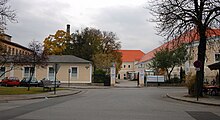Vöslau worsted yarn factory

The Vöslauer worsted yarn spinning mill was a textile company in Bad Vöslau in Lower Austria.
history
The company was founded in Bad Vöslau in 1834. The founder was Johann Heinrich von Falkner-Geymüller , who owned the Vöslau rule, together with Carl Deahna and Emil Rhode. The factory was built on an area of 24,500 m². Two years later it had 240 employees.
In 1839 there were companies with laundries and spinning mills in Vienna , Budweis and Kamnitz with a total of 700 employees. Due to Geymüller's lavish lifestyle, the company got increasingly into financial difficulties, so that in 1846 it was converted into a stock corporation and came into the possession of some major shareholders. In 1854 Friedrich Schey von Koromla became director of the company.
A second worsted spinning mill was put into operation in Möllersdorf not far from Bad Vöslau in 1875 . End of the 19th century, the major shareholders were the banks Rothschild and Gutmann and Creditanstalt . In 1906 another plant was built in Kreschitz in Bohemia. In the next few years, the takeover of and mergers with other spinning mills followed, such as the Bielitz-Bialer worsted spinning mill and then the Brno worsted yarn spinning mill . The company grew to 4,000 employees by the First World War , of which around 3,000 were employed in what is now the republic.
During the First World War, production came to a standstill in most of the factories, but could be restarted after the war. Only the corporate structure was changed in such a way that the Austrian companies and the now foreign companies were combined in a Zurich holding company. At the end of the 1920s, Vöslauer had between 2,000 and 2,600 employees; before the start of the Second World War it was around 3,500 through a directly associated subsidiary in Ödenburg . The production line was expanded vertically to include dyeing and finishing from pure raw material production.
Even after the Second World War, the company was a large employer; in Bad Vöslau alone, up to 4,000 people worked in the 1950s. In 1978 the Vöslauer Kammgarnfabrik AG had to file for bankruptcy due to the global structural change in the textile industry .
In 1983, large parts of the factory site were sold from the bankruptcy estate to a group of investors around the entrepreneur builder Manfred Koizar. The new owners gradually adapted the buildings in order to rent them out as storage and office space. In 2002, Koizar's partner left the ownership community and the master builder's two sons, Manfred jun. and Werner, took over their shares. Since then, large investments have been made continuously to improve the building fabric. The area, now known as the “Kammgarnzentrum”, currently houses around 40 independent tenants, including a health center in which more than 30 doctors and therapists ordinate, several businesses, a veterinarian, a dance school, offices, storage rooms, etc.
The Traiskirchen City Museum was set up in the branch in Möllersdorf. It still shows parts of the industrial operation and, with a museum area of over 3,000 m², is the largest museum of local history in Lower Austria.
literature
- Franz Mathis: Big business. Austrian large companies in brief presentations . Oldenbourg, Munich 1987, ISBN 3-486-53771-7 .
Web links
- Excerpt from Big Business in Austria
- Bad Vöslau elementary school
- Entry on Johann Heinrich von Geymüller in the Austria Forum (in the AEIOU Austria Lexicon )
- The Vöslauer worsted yarn factory today
Coordinates: 47 ° 58 ′ 7 ″ N , 16 ° 13 ′ 14 ″ E
